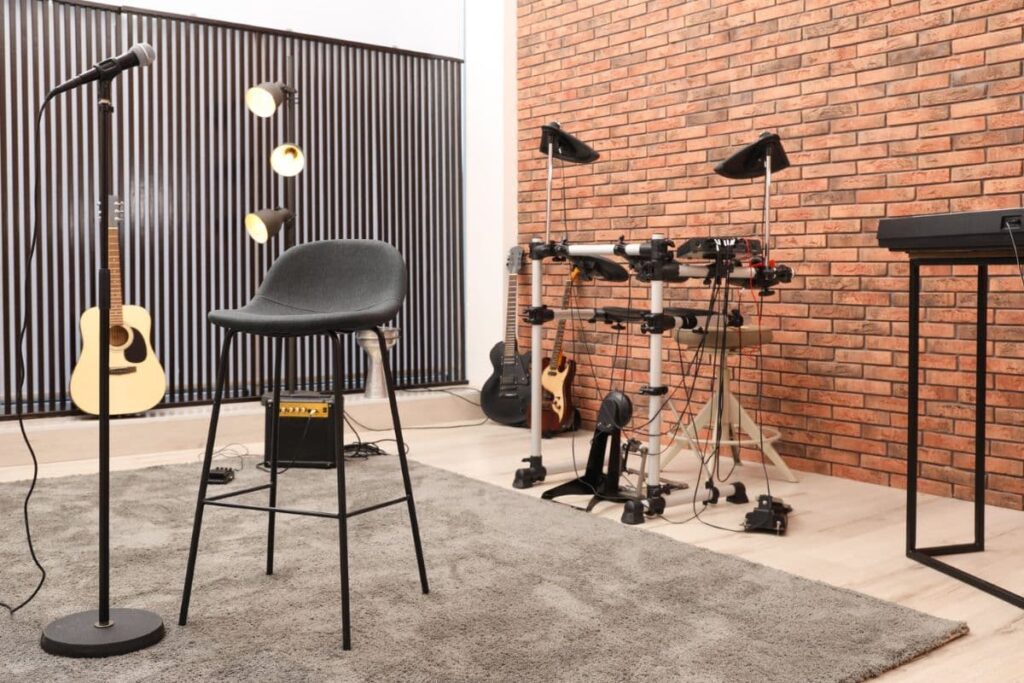Choosing the right noise floor makes a world of difference. If the noise floor is too high, you’ll hear a lot of background noise. On the other hand, a low noise floor will make it almost impossible to hear what you record. Furthermore, you might hear gaps in the recorded sounds because some of them won’t register.
An acceptable noise floor for recording is anywhere between -60db to -80db. You can reduce the noise floor by adding soundproof foam, acoustic panels, and dense rugs. Use an audio interface with a digital audio workstation to adjust the noise level and sound reduction signal.
Throughout this post, we’ll explain how you can find the perfect noise floor for recording, what happens when you go too low or too high, and how you can test your noise floor.
Table of Contents
- What Is a Good Noise Floor for Recording?
- What Happens if Your Noise Floor Is Off?
- How Can You Reduce Your Noise Floor?
- How Can You Test Your Noise Floor?
- Final Thoughts

What Is a Good Noise Floor for Recording?
A good noise floor for recording should prevent white noise without reducing the noise gate enough to silence the incoming audio. You should be able to hear everything you intentionally record without dealing with feedback, background sounds, fans, air conditioners, and so on. The good news is that the noise floor is quite easy to adjust.
Such a Voice claims your recording noise floor should be -60db or lower. This noise floor range lets you control and limit external noises without hindering your recordings. Many audiobook recording studios, music studios, and other professional settings require -60db to -65db. Even a few db higher will trigger a series of issues that might prevent submissions.
It might seem tedious or overly precise to require such noise floors. However, having the wrong noise floor can ruin a recording. You can have the perfect audio clip, but an extreme noise floor will tarnish the final results. Read on to learn more about what happens when your recordings have an incorrect noise floor.
What Happens if Your Noise Floor Is Off?
If your noise floor is off for your recordings, you’ll hear unwanted sounds (including white noise) or you won’t hear anything at all. A high noise floor prevents you from hearing all of the frequencies coming from your vocals, instruments, and anything else you record. It’s important to manage and adjust the noise floor as necessary.
Here’s what happens when you don’t maintain the noise floor:
- Produce Like a Pro explains your recording will have hums and buzzes if the noise floor is too low. Excessive noise comes from a low noise floor. It needs to be high enough to prevent it from picking up every sound that happens. For example, you might hear HVAC units, cars driving outside, and so on.
- You might not be able to hear everything you recorded. When the noise floor is off, it prevents white noise from being recorded. However, it’ll also prevent you from hearing your vocals, instruments, etc. You might hear the louder notes, but the quiet, subtle tones will be missing from the final recording.
- Your recording monitoring program might not pick anything up. DAWs (digital audio workstations) often have noise floor adjustments. Moving the noise floor too much (or the noise gate, for that matter) will stop it from registering audio signals. You’ll end up not hearing anything coming from the speakers.
- There’s a chance you could hear the signal’s frequency (white noise from the program, audio interface, or microphone). Some microphones produce higher decibels than others. If you have a low-end microphone, it’ll register in your recording program when the noise floor isn’t around -60db.
How Can You Reduce Your Noise Floor?
You can reduce your noise floor with these suggestions:
- Use sound-absorbing foam panels. The Fstop Labs Acoustic Foam Panels come in 12” x 12” x 2” sets. These panels drastically reduce the white noise by preventing sounds from echoing and reverberating. You can also choose from multiple colors and sizes to decide which panels work best for your recording studio.
- Choose the right kind of microphone. If you haven’t bought a microphone yet, look for the sound output of each one you think about buying. Some microphones emit up to 20db, drastically increasing the noise floor. Choosing a low-decibel microphone will help you adjust the noise floor much easier.
- Opt for dense curtains, rugs, and so on. Density is much more influential than anything else when you’re reducing white noise. Since white noise directly impacts the noise floor, density is your best friend. Lowering your noise output lets you reduce the noise floor, preventing unwanted signals and white noise.
Note: Avoid nose reduction add-ons. While the built-in noise editors work, add-ons typically compress the recording. You’ll end up with a lackluster recording that doesn’t sound nearly as clear or crisp as the initial recording.
How Can You Test Your Noise Floor?
To test your noise floor, follow these steps:
- Turn on your microphone or audio interface, then open your desired digital audio workstation.
- Click ‘record’ and wait for ten to fifteen seconds without making any noise.
- Listen to the recording to hear the noise floor (excess white noise means the noise floor is too high).
- The Seasoned Podcaster suggests using built-in noise floor adjustments after swapping out each piece of hardware to know why your noise floor is too high or low.
Keep in mind that many DAWs also let you change the noise gate. You can adjust the incoming volume and gain from your DAW, AI, microphone, or instrument. Both of these alterations will impact the noise floor because they can be too loud. However, manually lowering the noise floor through the DAW will help you reduce the incoming volume and gain.
Before you leave, you should read my ultimate guide on soundproofing a home studio. You’ll learn about four different mechanisms for soundproofing. The Ultimate Guide to Soundproofing a Home Studio
Final Thoughts
Changing the noise floor can be difficult if you don’t have the right equipment. Some microphones put out a lot of noise, making it hard to get to the desired range. Many recording submissions require a specific noise floor. Make sure you turn on noise monitoring so you know what sounds you can hear in the final recording.
- Review of the ALABS IRON MINI-WL: A Powerhouse Wireless Microphone - October 4, 2023
- What is a Saturator in Music Production: A Brief Explanation - May 11, 2023
- What Are Rotary DJ Mixers? An Overview - May 11, 2023
SoundStudiomagic.com is a participant in the Amazon Services LLC Associates Program, an affiliate advertising program designed to provide a means for sites to earn advertising fees by advertising and linking to Amazon.com. We also participate in other affiliate programs which compensate us for referring traffic.

